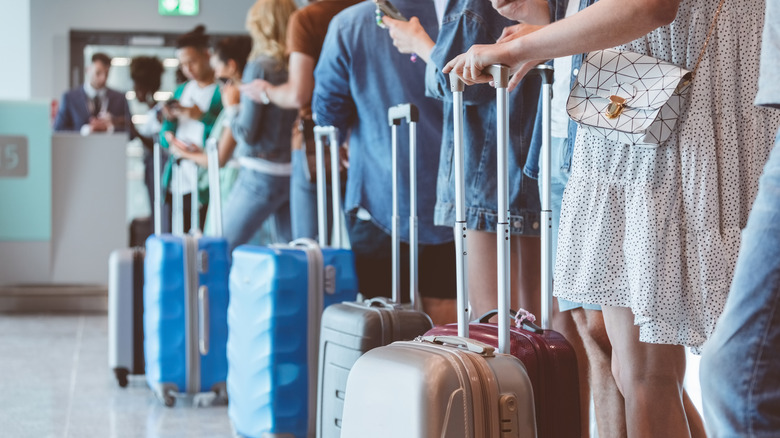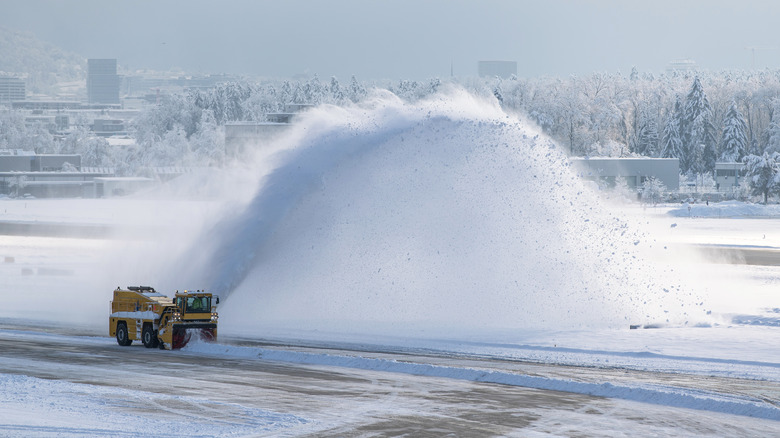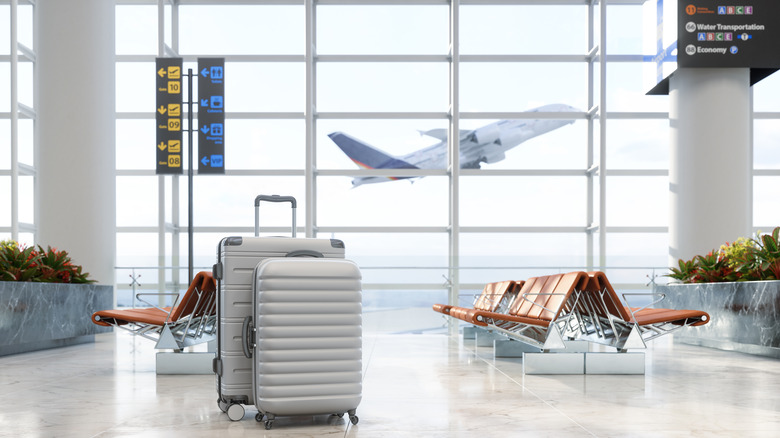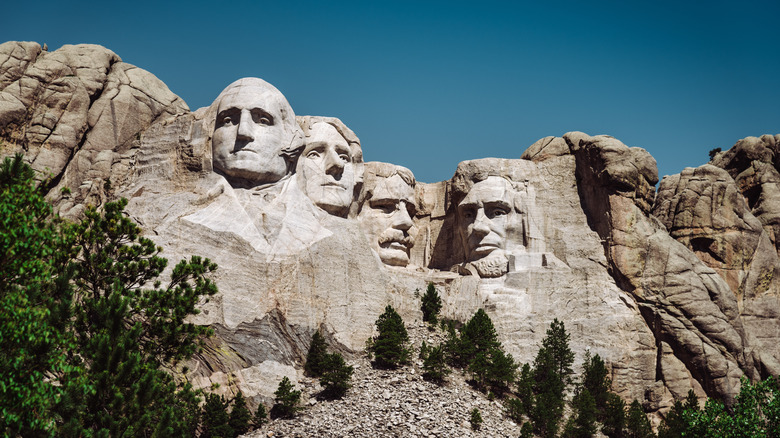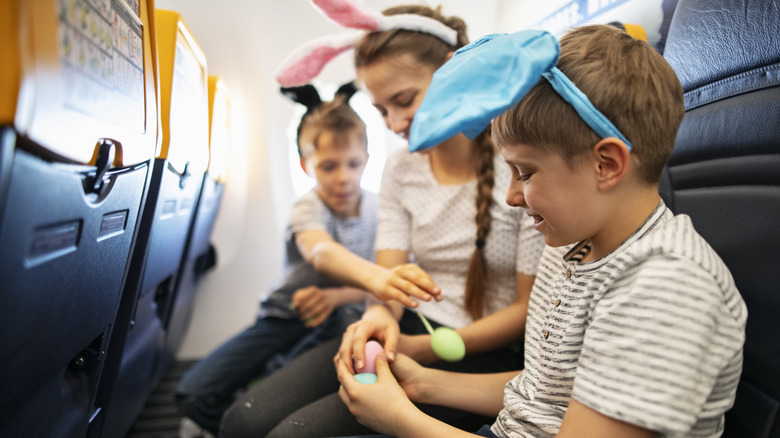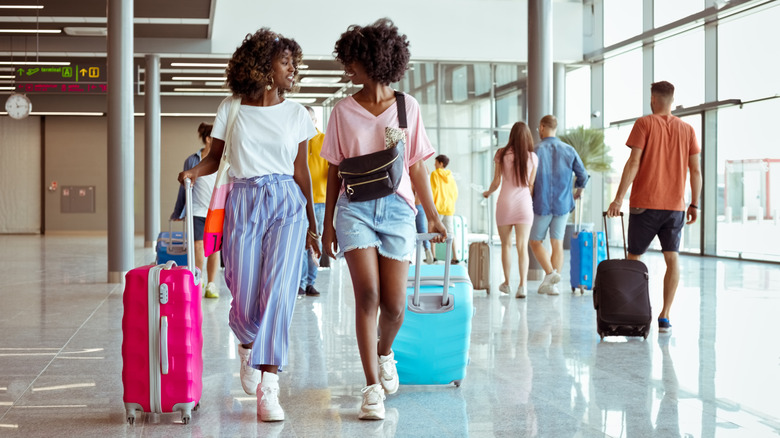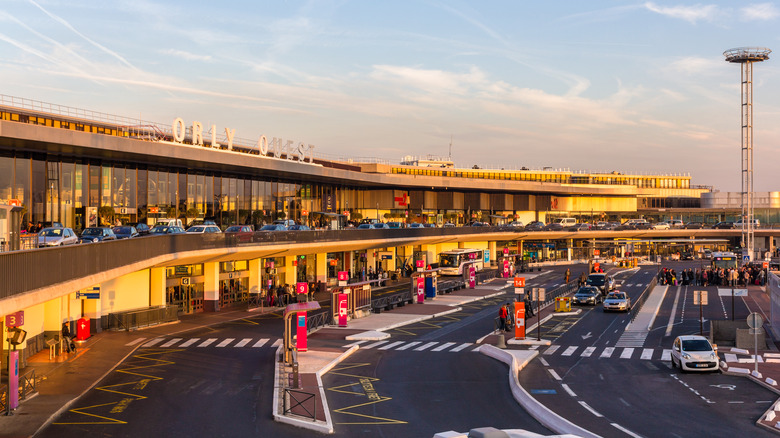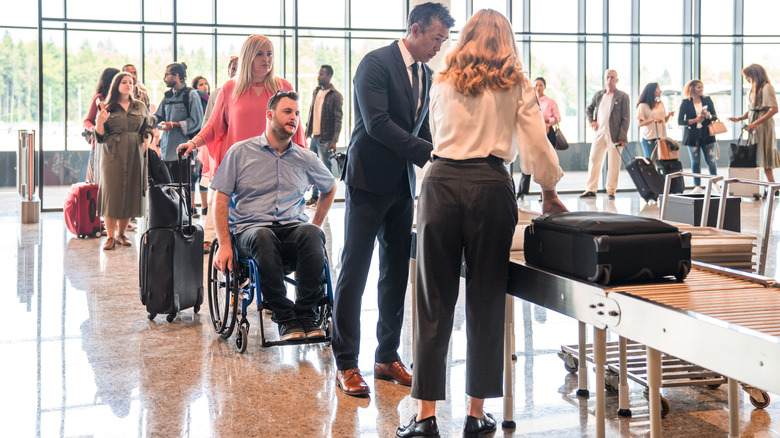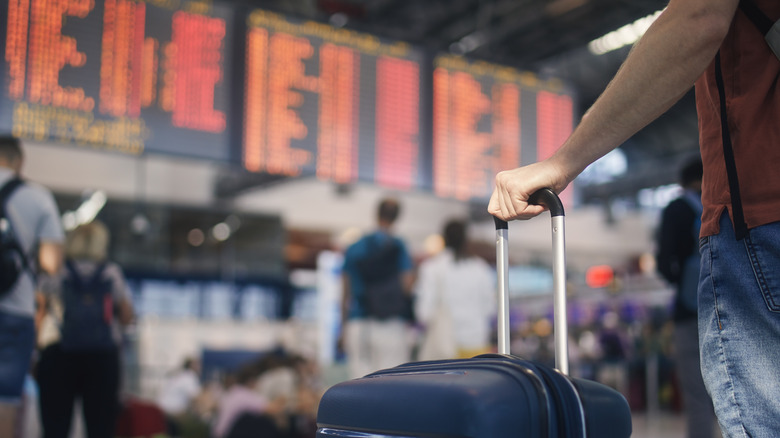Avoid Flying On The Worst Days Of The Year For Your Sanity
Let's be frank — flying is not reliably fun. It is often, in fact, an incredibly stressful experience. From trying to snag a reasonably priced fare to the dilemma of whether to pay for seats or baggage in advance (here are some tips on avoiding baggage fees), even booking a ticket has become harrowing in its own way. Then there's the complex choreography of the airport experience, from check-in and bag drop to security screening and waiting for your zone to board at the gate. Once onboard, you encounter packed seats and limited overhead bin space (although we know a few hacks for securing this scarce resource on your next flight). The incidence of unruly passengers also appears to have risen in recent years.
Of course, everything can go smoothly, and the flying experience can feel as uplifting as a feather floating on a spring breeze, especially if you avoid making the rookie mistakes of a first-time flier. If there is one thing that can consistently hurt the flying process, it's massive crowds. At times throughout the year, airports fill with people, lines get longer, and tensions boil over. Days like these can be nerve-shredding, adding more obstacles to a procedure already resembling a pressure cooker. We've looked at data published from sources such as the Federal Aviation Administration (FAA), Transportation Security Administration (TSA), and global travel data provider OAG and found occasions and patterns throughout the year when numbers seem to peak. Do yourself a favor and try, whenever possible, not to book a flight on the days below.
The beginning of January
New Year's Eve is a monumental time of celebration for many individuals around the world, even in countries that don't religiously follow the Gregorian calendar. It's a point in the year when people travel to partake in festivities, sometimes flying across the country or even the globe to let loose and usher in another year. Once that celebration ends, they must return home, especially if they have to resume work or school shortly after that. While New Year's Day is a time often reserved for recovery and light on travel, the following two days, January 2 and 3, usually see a bump in passenger numbers, according to data from the TSA. Per FAA figures, cancellations also tend to be highest in January.
Martin Luther King, Jr. weekend
A study by CheapAir.com identifies January as the cheapest month to fly. According to data from the Bureau of Transportation Statistics, passenger numbers also hit some of the year's lowest levels during this month. However, around the long weekend of Martin Luther King Jr. Day, celebrated on the third Monday of January, TSA figures show a rise in passenger numbers on the Thursday and Friday before the holiday and the occasion itself. In 2024, the passenger numbers jumped from 1,925,737 on Wednesday to 2,284,892 on Thursday before MLK Day. This represents an increase of almost 19%. The number of fliers on Friday soared even higher.
Presidents' Day
Falling on the third Monday of February, this federal holiday can trace its origins to the celebration of George Washington's birthday, February 22. (The government still refers to it as Washington's Birthday). For some, Presidents' Day offers a chance to take a small break in the middle of winter to escape frigid conditions for sunnier climes. At Walt Disney World, one popular destination, the week around Presidents' Day has become one of the busiest times of the year. TSA data shows a clear rise in airport traffic during this period, with a blip on the Thursday before and the Monday of Presidents' Day. Often, travelers extend the break to one whole week since some school districts close for that period.
Weekends in March
As winter draws to a close and spring break approaches, TSA statistics detail a rise in flight numbers over weekends in March. The exact day of spring break varies from state to state and among institutions. In 2024, for instance, some California universities had a spring break beginning in late February, while high-school breaks ranged from mid-March to early April. This uptick in travel numbers isn't confined to March, though — it continues through April and May. Higher demand can explain higher prices, as one Reddit poster noted, asking, "Why are flights so expensive to Seattle the second week of March?"
Around Good Friday
Good Friday is not a federal holiday; however, many people take trips during this time, according to the travel compensation firm AirHelp. A study by the company that looked at Easter flights in 2018 noted that Good Friday experienced the largest crowds during the period. It also examined travel problems during these days and noticed a few routes — like San Francisco to Los Angeles and New York to Toronto — suffered multiple disruptions. Airports fill up over Easter weekend. As one commenter based in the United Kingdom suggested on Tripadvisor, "Arrive early at Easter. People are drawn to airports like flies on a freshly laid cow pat."
The days leading up to Memorial Day
This federal holiday on the last Monday of May, once known as Decoration Day, exists to remember people who died in wars, near and far, and dates back to the late 1800s. In a poll by Rasmussen Reports, 80% of respondents also viewed Memorial Day as the unofficial beginning of summer, when travel picks up. TSA stats show that more than one week before Memorial Day, the number of people flying surges. In 2019, 2022, and 2023, on the Thursday 10 days before Memorial Day, passenger numbers increased by about 250,000 people or more compared to one day earlier.
Fridays and Sundays mid-June
As schools close their doors for the end of another academic year and the days in the Northern Hemisphere continue to stretch out, travelers look to get away. According to the Expedia Summer Travel Outlook report for 2024, the most expensive time to fly domestically and internationally falls at the end of June. As TSA data shows, passenger figures also begin to creep up during this time of year. In fact, June 30, 2023, saw the highest number of passengers screened at U.S. airports (almost 2.9 million people) up to that point. However, that number was surpassed on November 26, 2023, with more than 2.9 million passengers. Nonetheless, June is a busy month in the air.
Days around July 4
Of course, July 4 falls on a different day of the week each year. But, as a general rule, the dates around it see passenger numbers ratchet up. The Expedia Summer Travel Outlook predicts that the week before July 4 will find airports at their most congested during the season. As a poster on Reddit noted, "There is often tremendous domestic travel that happens on July 3 and July 5, and sometimes the morning of July 4." Looking at TSA data over several years, however, July 4 tends to have significantly fewer fliers than the surrounding days.
Summer weekends
Looking at data for 2023 published by the Bureau of Transportation Statistics, on-time arrivals reached their lowest during June, July, and August. During this period, flight numbers tend to rise starting on Thursdays. The third and fourth busiest days for passenger numbers in the U.S. 2023 fell on Sundays in July. This pattern of busy weekends occurs throughout the summer, all the way through August. In fact, statistics compiled by OAG show that the busiest travel date in 2023 was on August 11. On that Friday, almost 19 million people took to the skies across the world.
Labor Day weekend
The three-day Labor Day weekend at the close of August and the start of September signifies the end of summer and acts as a last hurrah of sorts for warm-weather travelers. Kids go back to school, work routines tighten, and daily life begins to resume for many. The Friday of the weekend is the busiest day for air travel, according to the TSA. Looking at the statistics from 2023, individuals who wish to travel around that time but lessen their chances of hitting big crowds should plan their trip to leave on the Wednesday before Labor Day and return the Wednesday after it. The drop in numbers on those days is significant compared to either side of them.
Weekends in September
September is traditionally an excellent month for air travel. The prices of airfares retreat from their summer peaks when demand goes through the roof. The weather in the Northern Hemisphere remains great, and in places like Greece, the water is warm after soaking up all that summer sun. With many people back at school or work, crowds are visibly thinner than in the previous season. And yet, weekends during this month tend to see a spike in air travel, with the peaks most evident on Thursday, Friday, Sunday, and Monday throughout September. Travel outside those days, and the airport experience will likely be much more serene.
Around Columbus Day
The first federal holiday after Labor Day, this October break ushers in a period where the skies fill up. According to TSA data, the Sunday after Columbus Day was among the top five busiest days in 2023. This begins on the Thursday and Friday before, even the day before Columbus Day, and extends as far as the following Thursday and Sunday. In 2019, the Port Authority of New York and New Jersey even labeled the days around Columbus Day as Peak Travel Days. As a commenter on a Tripadvisor forum page opined, "The only time I've had a really ugly airport taxi line experience was Columbus Day weekend. Over an hour in line at the airport on the Friday night of the holiday weekend."
Before and after Veterans Day
While November is the month of travel-saturated Thanksgiving, this break earlier in the month gives people a chance to take a trip before the madness a few weeks later. According to the FAA, it is also among the busiest travel weekends of the year, based on the number of flights. Usually commemorated on November 11 (although, if that falls on a weekend, the Friday before or Monday after that becomes the federal holiday), it honors living veterans. This contrasts with Memorial Day, which remembers soldiers who have perished while serving the country. While the window around Veterans Day isn't the busiest time of the month for flying, it certainly sees a rise in passenger numbers.
The mother lode of Thanksgiving
A holiday unlike any other in the United States, Thanksgiving is the one time of the year that families make an extra effort to get together. It's a period of intense travel by planes, trains, and automobiles. Every year, tens of millions of Americans hit the road to get home for a special dinner or try to snag a Thanksgiving travel deal. The vast majority travel by car, but the airports are also packed. The days leading up to Thanksgiving, including the Friday before and the day before Thanksgiving, are especially busy, per TSA statistics. One day to avoid returning home by plane is the Sunday after Thanksgiving — the 2023 number of more than 2.9 million passengers screened broke all TSA records.
Around Christmas
Commenting on NPR in 2023, Scott Keyes of travel site Going.com suggested that travelers should not make air travel plans around two specific times of the year: Thanksgiving and Christmas, when crowds, air ticket prices, flight delays, and cancellations peak. When thinking about flying during those periods, he stresses, "If at all possible, just don't do it." Before Christmas, especially on December 22 and 23, the mass of fliers rises. And what goes up must also go back, with passenger numbers increasing just after Christmas. Another climb was seen just before the New Year, as TSA data shows. The Port Authority of New York and New Jersey, which oversees the airports of La Guardia, JFK, and Newark, experienced its busiest-ever December in 2023, with about 12 million people flying from the airports that month.
Methodology
As technology progresses and the global population grows, air travel has flourished. From about 25 million flights around the planet in 2004, the numbers have increased to more than 38 million, with forecasts for the 2024 figure to top 40 million (via Statista). That's a lot of flights and fliers, and the skies have never been busier. Bureau of Transportation Statistics data also show the meteoric growth in air travel. About 670 million passengers flew from U.S. airports in 2002, which has since passed 1 billion. Unsurprisingly, the U.S. is home to the busiest airport in the world.
There are no dates at airports where check-in counters are empty, or you'll find TSA screeners twiddling their thumbs and waiting for passengers. But some days of the year are markedly more overloaded than others and are best avoided if possible. We analyzed data from the TSA, looking at a few years of statistics, to identify dates when airports are mobbed. We also consulted other government statistics, such as FAA numbers and online forums like Reddit and Tripadvisor, to round out our findings.
